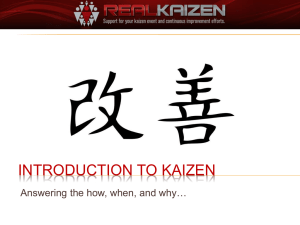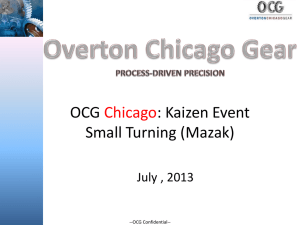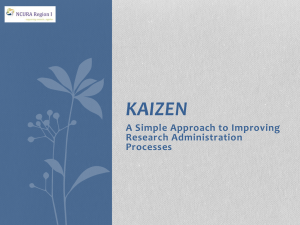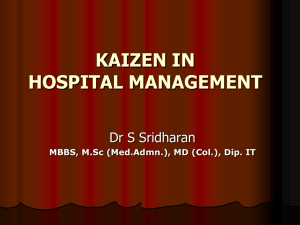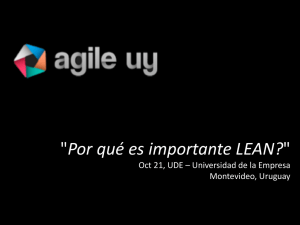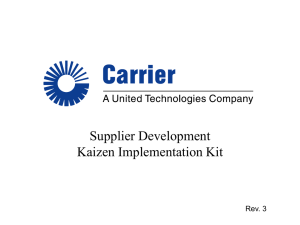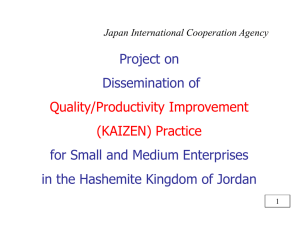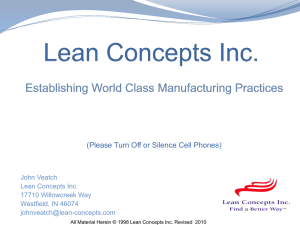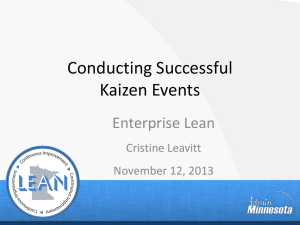LT6 Training
advertisement
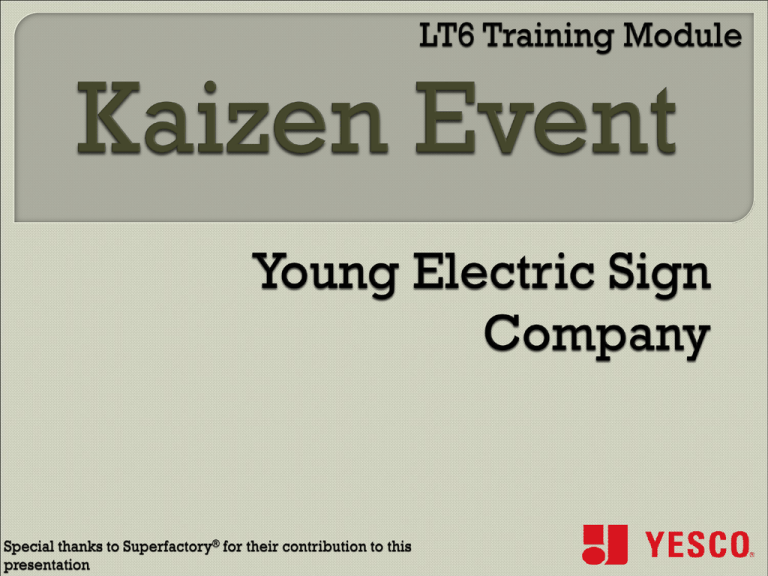
Discussion 45 minutes Break 5 minutes Discussion 40 minutes Will understand what a Kaizen “event” is Will be able to plan and carry out a Kaizen event Will understand the benefits, the why Will understand those pitfalls to avoid What are your expectations? Kaizen (Ky’zen) • “Kai” means “change” • “zen” means “good (for the better)” • Gradual, orderly, and continuous improvement • Ongoing improvement involving everyone Modern Kaizen is based on the principles of the Toyota Production System (TPS). TPS is a system used in repetitive manufacturing, but the philosophy can be applied to all operations. Companies in the United States began to use the term following the publication of Kaizen by Masaaki Imai in 1985. Selecting Projects Setting Goals The Team and Team Leader Setting the Stage The Kaizen Blitz Potential Roadblocks Kaizen Steps • Set the scene • Observe the current process • Develop the future state process • Implement the new process • Report and Analyze Desirable criteria for initial projects • Easily measured • Management shows enthusiasm • A clear business need • Highly visible process • Easier project • Strong environment for follow-up • Simple process • Stable and repeatable process • Allows contribution by all employees – not just a technical exercise • Self-contained process Productivity improvements • Typical goal: improve productivity by 30% Changeover or setup time improvements • Typical goal: reduce setup time by 90% One piece flow/Pull Systems • Typical goal: reduce inventory by 50% Any process that needs to be improved Remember, “everything we do is a process, and every process can be improved” Goals from previous slide may seem high, but: Set goals high • To challenge the team to think out of the box • Try radically different approaches Team LEADER Typically not “the supervisor” Preferably has experience with the kaizen process Should be biased toward change Be open-minded Team MEMBERS 3 to 10 people (including Team lead) From across all levels and functions impacted by the project Include experts – if they have open minds Include people with prior kaizen experience Include outsiders from unrelated functions to obtain different points of view • “Dumb” questions often stimulate innovative thinking Eliminate interruptions for team members • No cell phones • No visitors • Dedicated conference room • Eat together Supplies • Flip charts • White board • Snacks Management support • Team members need full support of management • Responsibilities are covered to eliminate interruptions during event Conference room can be used for analysis, discussion, introductions, etc Important to “go to the gemba” • “Gemba”: where the process actually occurs “Kaizen can happen right on the factory floor, information should be gathered at the gemba” Don’t be afraid of going back to the floor to challenge and test ideas Total focus on a defined process to create improvement in a short period of time Dramatic improvements in productivity, quality, delivery, lead-time, set-up time, space utilization, work in process, workplace organization Typically one to five days long Be open to change Everyone involved Stay positive Speak out if you disagree See waste as an opportunity No blame environment Treat others as you want to be treated Ask the silly questions, challenge the givens Creativity before capital Understand the data and principles Just do it! We already know the answer, wasting time to gather data A good idea but the timing is premature Can’t do, not in the budget That may work on paper, but not in reality It may work elsewhere, but it won’t work here Doesn’t match corporate policy I’ll do it my way when everyone looks the other way. Fear of accountability stops progress Isn’t there an even better way? PLAN • Day 1: Setting the scene Meet the team, identify stakeholders & customers, scope, train if necessary • Day 2: Observe the current process Flowchart, VSM, identify waste, identify root causes • Day 3: Develop the future state process Brainstorm and flowchart (typically the longest day!) DO • Day 4: Implement the new process Plan, communicate, implement, modify CHECK, ACT • Day 5: Report, analyze Performance VS expectations Act upon what has been learned: Standardize or back to the drawing board SET THE SCENE Stakeholders & Customers Those sanctioning the event • Those who might be impacted by decisions made by the team • What Does Done Look Like? Write a statement that expresses: 1) The work to be done; 2) The time frame to be done in; & 3) The expenses or resources consumed • Team consensus on “triple constraints” • Allow Stakeholders and Customers to approve • Train • Provide training on team and Kaizen etiquette, how the event will proceed Understanding your customer! Value added is always determined from the customer’s perspective. Who is the customer? Every process should be focused on adding value to the customer. Anything that does not add value is waste. Some non-valued added activity may be impossible to eliminate or reduce(“N-NVA”) • Regulatory • Legal • Can’t eliminate “right now” Observe Current Process! Crucial first step in process improvement Deep understanding of the existing processes and dependencies Observe the process first hand Value Stream map the process Observe Current Process! Take measurements – time, yield, travel distance Identify Value Added (VA), Necessary Non-Value Added (N-NVA), and Non-Value Added (NVA) • A process either Adds Value, or is Waste Identify Waste! Anytime we are not doing all three of these…. 1. Physically modifying raw materials… 2. In a way the customer wants, and 3. It’s done right the first time. Where to find waste? • • • • • • • • Defects Overproduction Waiting Non-utilized talent Transportation Inventory Motion Extra processing Identify Root Causes! Flow Charts Cause and Effect Diagrams Check Sheets Histograms Pareto Charts Scatter Diagram Control Charts Fishbone Daigrams Brainstorm Improvements Team brainstorms to develop new process Post improvement ideas on map or by category • Workflow • Technology • People / Organization • Procedures Develop detailed future state (VSM, Equipment, Training) • New workflow • Value Add and Non-Value Add • Cycle times • Identify Kaizen “bursts” (immediate radical change) Things To Consider… Think global / systems optimization Maximum impact to process Speed of implementation – create small victories Cost-benefit analysis Will new skill sets be required, and how to achieve them? Is the current organization structure sufficient? Are there cultural issues? Is there potential for “push back”? Any implications for suppliers? Implications for customers? Implications for team members? Do current technologies support the new process? Are they available and cost justifiable? Technology is an enabler, not a solution. Does the reward system support the new process? What can be done to accommodate any of these? Plan steps to New Process Plan • What specific changes need to occur • In what sequence • Resources needed – get commitment • Impact on existing activities and functions • Responsibilities Communicate • Who, what, when Execute The Plan Develop a concise, achievable milestone plan Communicate the plan to everyone • Suppliers • Team members • Stakeholders & Customers Track activities in public Celebrate small victories and publicly analyze failures If modifications to the plan are necessary, make sure to communicate to team members, stakeholders, and customers. Meet regularly (weekly?) to review status of open implementation items Report and Analyze Report results on a public Kaizen Board Compare actual results with expected What can be learned? What are the next steps to take? Standardize the positive • Share what was learned with others that may find the information useful • Are there more opportunities for improvement still on the table? If so, repeat PDCA through additional Kaizen events. • Celebrate! Questions management shows enthusiasm for, has a good business case, and will allow the involvement of many. Initially avoid processes that are out of control, are seen as not needing improvement, or are dependent on other processes. Gain experience before tackling difficult processes Set Goals: Set high goals for the team to achieve, typical results include: Productivity Improved by 30%; Setup reduced by 90%; Inventory reduced by 50% The Team: Leader is experienced, is inclined toward action, is open minded. Members (2 to 9 additional) have an interest, are ‘subject matter experts”, can be from outside the area of impact to ask “dumb questions”. Remember Team Etiquette Set the Stage: Know “What Done Looks Like”, Eliminate Interruptions, have supplies ready, make sure you have management’s support for event. Prepare conference room, be prepared to “go to Gemba”. Kaizen Rules: Be open to change, everyone involved, stay positive, speak out if you disagree, see waste as an opportunity, no blame environment, treat others as you want to be treated, ask the silly questions, challenge the givens, creativity before capital, understand the data and principles, Just do it! AVOID: Can’t Because…. Won’t work here, no need to study, already know the answers, going to do my way anyway. 1 – Set The Scene •Stakeholders & Customers, Scope, Training, Understand your customer (Voice of the Customer) to understand VALUE •Value Added, Non-Value Added, Necessary Non-Value Added. •Waste Vs Value Added •Where to find Waste (D.O.W.N.T.I.M.E.) •Day 2 – Observe Current Process •create current stateVSM, gather data, watch for VA, NVA and NNVA, find root causes of waste. •Day 3 – Develop Future State, Prepare PLAN •Brainstorm improvements to process •Create future state VSM •Develop written plan to go from current to future state •Include dates and responsibilities •Use Gantt chart or other method to track progress, display publicly •Day 4 – Execute •Publicly display plan and progress •Highlight “milestones” •Hold follow up meetings as necessary (planned) •Communicate progress to stakeholders, customers, and team members •Manage changes to plan •Day 5 – Report and Analyze •Report results publicly •Compare Actual to Expected •Understand differences between Actual and Expected •Standardize positives •What can be learned from negatives •Share what was learned with others who might benefit •Define next steps, more PDCA and Kaizen? PLAN •Day DO Select Project: Start with a project that is easily measured and Agenda: (Plan, Do Check, Act) (PDCA) Check & Act Kaizen (Ky’zen) Defined: Gradual, orderly, continuous improvement. Can be applied to ALL processes, Involves EVERYONE Kaizen Blitz: 1 to 5 day rapid, focused, intense Kaizen event •CELEBRATE
